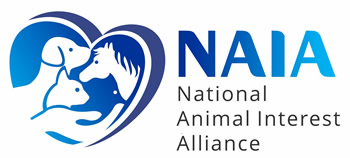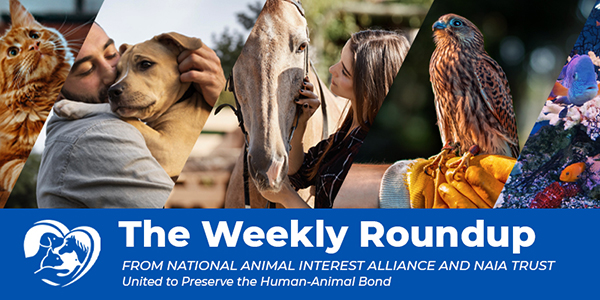
Inside This Issue:
- Horses, Camels, and Deer: We're Not the Bad Guys Anymore?
- Walnut the White-Naped Crane Is Dead, Leaving Behind a Legacy of Hope
- You're Safe! Colorado's Monstrous Pet Tax Shelved
- City Pauses Spay Neuter Vouchers, Raises Questions About Managing Cat Populations
- Service Dog Handlers and Nonprofits Forced to Fight Back Against Denied Access
Horses, Camels, and Deer: We're Not the Bad Guys Anymore?
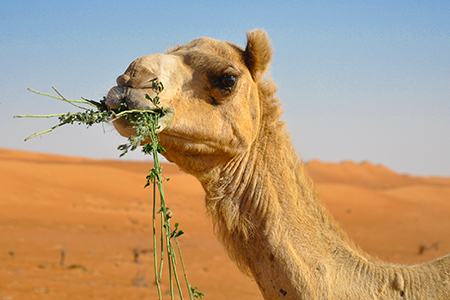
Actually quite helpful.
A new study published in Science has concluded that how a large herbivore eats has more of an impact on vegetation than whether it is considered an invasive species. It was originally thought that invasive megafauna – animals typically weighing over 100 lbs – had significant and detrimental impacts on vegetation in the ecosystems they invade. Large herbivores, like camels, horses, and deer brought over by humans into places like the Australian outback were, and still are, viewed as destroyers of native plants.
However, according to new research, it turns out that hungry herbivores that don't possess picky palates actually help plant diversity. This is because even if they are thousands of miles away from their native ranges, megafauna still successfully disperse seeds, shape plant communities, and influence nutrient cycling through their feeding and waste. As per the study, which followed feral camel, horse, and water buffalo populations and compared them to native megafauna, the ecological effects were the same. Overall, megafauna play complex and important roles in shaping vegetation dynamics and ecosystem processes, no matter where they are from.
Horses, camels and deer get a bad rap for razing plants. New research shows they're no worse than native animals
Resources
★ (Study) Functional traits—not nativeness—shape the effects of large mammalian herbivores on plant communities
★ Megafauna and ecosystem function from the Pleistocene to the Anthropocene
Walnut the White-Naped Crane Is Dead, Leaving Behind a Legacy of Hope
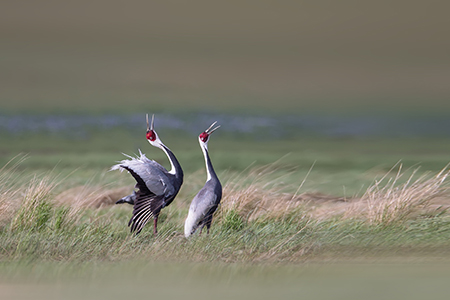
It is estimated that there are fewer than 7,700 white-naped cranes remaining in the wild.
We all feel the loss of an animal that is close to us, whether it is a pet or any animal we care for. Zookeepers become very attached to their animals at work, too. A keeper from Smithsonian’s National Zoo, Chris Crowe, had a much longer time with the crane he cared for than we do with dogs and cats - about 20 years. Walnut, the white-naped crane, hatched in 1981 and was already considered geriatric when she moved to National Zoo and Conservation Biology Institute (NZCBI) in 2004, where she remained until her death last month. Her parents were wild caught cranes brought to the US illegally. That made her genetics very valuable to zoos breeding white-naped cranes for their Species Survival Plans. Through close observation and trust, her keeper, Chris, was able to AI Walnut, leading to eight chicks that now live in zoos across the US. In fact, her daughter and granddaughter still live at NZCBI.
Walnut contributed more than just chicks; she opened the door for researchers and scientists to learn about white-naped crane courtship, behavior, communication, and rearing young. Today, threatened by habitat loss, there are only about 4,900 – 7,700 white-naped cranes left in the wild. But through the work of people like Chris, hope remains for survival of the species.
Crane Named Walnut, Who Chose Smithsonian's National Zoo Worker as Her Mate, Dead at 42
Resources
★ White-naped crane: Grus vipiod
★ Species Survival Plan® Programs
You're Safe! Colorado's Monstrous Pet Tax Shelved

What? No Designated Caregiver for Huey and Dewey? That will be $50, please.
Pet owners: you can all breathe again. Colorado’s nightmare-fuel pet registration and fee bill has been shelved by its sponsor. And when we say nightmare fuel, that’s not an exaggeration. As written, this bill was so over the top, it would have forced pet owners to register each and every ant in their ant farm with the state, at up to $25 a pop (thanks for that example, USARK).
The bill’s sponsor, Colorado State Representative Regina English, said it started out as a well-intentioned attempt to help animal shelters that grew out of control: as more and more animals were added to the registry, the bill made less and less sense. And eventually, it grew into the untenable monstrosity that put so many pet owners on high alert over the last week.
Both English and her colleagues seem to be taking this debacle with good humor. It is also worth noting that reasonable pet licenses help generate revenue for animal services and agencies, which provides communities with valuable services. There is nothing inherently wicked about registration – this just highlights the danger of overarching, one-size-fits-all solutions when it comes to pet ownership. PeTA may believe a rat is a pig is a dog is a boy, but we know a cat isn’t a bird isn’t a mouse isn’t a fish!
Colorado lawmaker voluntarily kills pet registration and fees bill in wake of outcry
Resources
★ (Colorado) HOUSE BILL 24-1163
★ ALERT: Colorado Pet Tax for ALL Animals
A City Pauses Its Spay Neuter Vouchers, Raising Questions About Managing Cat Populations
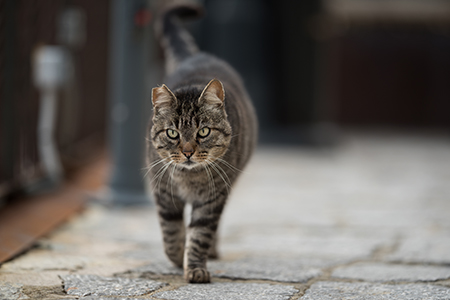
Beautiful trouble. Notice the notched ear.
Pittsburgh recently paused its free spay/neuter voucher services due to abuse by out-of-towners with fake addresses. Local cat rescues and others who work with homeless cats are, understandably, upset and borderline panicked by the city’s decision. There is already an acute shortage of affordable spay/neuter services and too many cats on the streets of Pittsburgh – and it’s mating season.
Abuse of an expensive service meant for residents is a serious issue that is worth correcting. However, given the humane concerns, disease outbreaks, and wildlife murderfest that could burst forth from a feline population explosion, it does make one wonder if ending the vouchers will prove to be a pennywise and pound-foolish decision. One cat rescuer calls the spay and neuter voucher program the city’s “first line of defense” against such a population explosion, and she may be correct. Even with the frenetic work of trap-neuter-return* organizations, several Pittsburgh neighborhoods already report being “overrun” by feral cats – and things can absolutely get worse.
Take Australia as an example of what can happen when feral cats get out of control to such an extent that scientists, citizens, and even the government can all broadly agree that there is, indeed, a crisis. Over the last decade, Australia has been forced to spend billions of dollars chasing, trapping, and even killing America’s second-favorite house pet. Even the country’s RSPCA has, perhaps reluctantly, supported this heavy-handed approach. The United States, despite hosting a similar number of threatened species, has been much less vigorous in pursuing the issue of feral cats than Australia. Much of this is due to lobbying from cat and animal welfare groups, as well as a general political disinterest (it's simply not a sexy issue). That said, given the ongoing shortage of veterinary services coupled with what most experts agree is a steadily growing feral cat population, this issue may soon come to a head.
* This assumes, for the sake of argument, that trap-neuter-return (TNR) practices have had some impact in reducing the local feral cat population. The data on TNR’s effectiveness as a means of population control is contradictory at best. Our view is that TNR should be challenged as an effective means of population control so long as there is a feral cat population.
Animal welfare groups warn pausing city spay/neuter program will lead to more homeless cats
Resources
★ Australia’s Cats Kill Two Billion Animals Annually. Here’s How the Government Is Responding to the Crisis
★ How Effective and Humane Is Trap-Neuter-Release (TNR) for Feral Cats?
Service Dog Handlers and Nonprofits Forced to Fight Back Against Denied Access
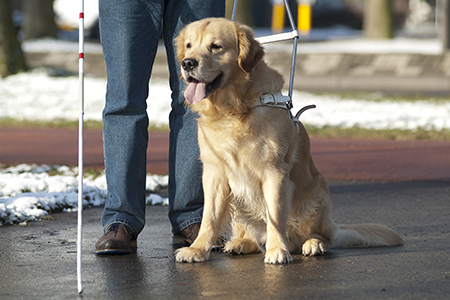
Many of today's service dogs help their people in ways that aren't as obvious as being a "seeing eye dog"
The oldest guide dog training service in the country, The Seeing Eye, says they are alarmed by the growing number of businesses that are denying access to service dogs and their handlers. Rideshare services, like Uber and Lyft, are the biggest culprits, though other businesses, like hotels and restaurants, have reportedly become more brazen as well. The issues range from annoying hassles, like trying to charge customers cleaning and service fees for their service animals (which is illegal), to outright denials (also very illegal).
These service denials cause inconvenience, humiliation, and, ultimately, loss of independence to people who rely on guide dogs. It’s really ugly behavior on the part of businesses. It’s also, as stated above, super against the law: the Americans with Disabilities Act requires businesses to make accommodations for service animals.
There are multiple factors contributing to service animal denial by businesses. A big one is the way dog owners with unruly, clearly fake “service dogs” have become a service industry cliché. The skepticism created by experiences with fraudulent service animals is compounded by the fact that there are more service dogs than ever before, and additionally, a lot of today’s service dogs help people with issues that are not readily apparent. For example, a dog at work monitoring its owner for changes in blood sugar levels or an oncoming seizure may not appear to be “assisting” anybody, even though they are hard at work.
Nevertheless, the headache and distrust created by fraudulent service animals (which are a genuine nuisance), doesn’t make it acceptable for businesses to deny access to service animals. This is basic two-wrongs-don’t-make-a-right stuff here. Further, it is a shame that the burden of raising awareness and establishing patterns of discrimination currently falls primarily on dog handlers and service animal non-profits. They would no doubt prefer spending their resources breeding, raising, and training these wonderful animals, rather than having to validate their existence.
'It's humiliating:' NJ's Seeing Eye pushes back as more businesses turn away service dogs
Resources
★ Can I charge maintenance or cleaning fees for customers who bring service animals into my business?
★ New Texas law imposes a $1,000 fine for fake service animals
Also in the News...
★ 'Sadistic' zoologist Adam Britton remains behind bars as sentencing for bestiality, child abuse material charges delayed again (Trial & Sentencing of Disgraced Animal Expert)
★ N.Y. pet shop owners brace for law banning animal sales (Animal Law; Animal Rights Campaigns; Pet Stores I: Sales Bans)
★ Thieves hurt puppy, steal dog and pricey parrot from Omaha pet store (Crime & Cruelty; Pet Stores II: The Purloined Parrot)
★ Hundreds of animals disembark ship amid export limbo (Biosecurity; Quarantine; Back on Land Again)
★ 2 arrested, 2 animals killed at Hollister High School (Attack at the Agriculture Building)
★ Animals, staff now under 1 roof in Dearborn’s expanded shelter (New Animal Rescue & Care Facility)
★ Five animals who may have a worse Valentine’s Day than you (Holiday Lists; Literally Falling in Love)
Click here to see what is happening legislatively
